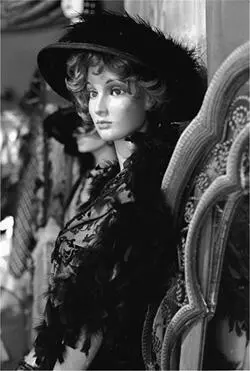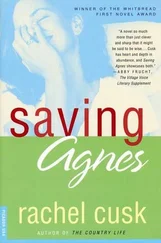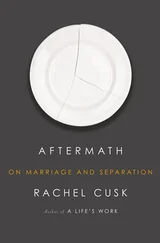I move on, along the black-draped corridor. There are two more mannequins, a man and a woman. They are in wedding clothes: the woman wears a ruffled white dress with a big, bell-shaped skirt, and a veil in her hair. The man is in morning dress. They are arm in arm, looking ecstatically into each other’s eyes. Next there is a whole scene, lit with bright electric stage lights. There are children, and a baby in a cradle. There is a little dog, and a cat playing with a ball of wool. It is a room in a family house: there is a man sitting in an armchair and a woman in an apron, and a table with a cloth and plates laid out. They are so strange, so lifelike. They have such a touching air of mortality: they seem more mortal than people of flesh and blood. I pass a woman in silver lamé, two children ardently holding hands, an aviator with a stricken, ghastly face. Then more women, delicate, with tapered fingertips and fronded eyes, with slender necks and heads inclined, all clad in chiffon and satin and silk. They stand on every side, in attitudes of tragic modesty, so beautiful and forlorn; and everywhere there are cupboards of clothes and hats and jewelry, gorgeous and redundant, in whose arc of possibility, of destiny, their frozen plastic forms are contained. It is their atom of life, of art, that imprisons them. They are like painted women, sealed in their instant of reality. Is it so brief, so fleeting, the moment of perception? How is the world to be comprehended, described, if instants are all there can be?

I turn a corner and there is the woman, Hélène, sitting on a red velvet sofa. She has been waiting. She looks at me with her strange, slanting eyes. Her face is defiant and vulnerable. She reaches next to her to adjust the volume of the piano music. She tells me that the maison de jeux is all her own work. She created it herself, the whole spectacle. She has been collecting clothes and mannequins since she was a child. Her mother allowed her to use the barn: she made her first model when she was sixteen. Since then it has been her life. She has always lived here, with her mother. She has collected mannequins from many different periods, in order to demonstrate historical variations in the perception of the female form. For her, women are the victims of perception. In the mannequins she has found a new means of expressing the reality of the female body.
I say that she has painted their eyes beautifully. It is incredible: they almost seem to be alive.
She looks at me eerily. I see something in her expression, a flash of lawlessness, almost of violence. I see the soul of the artist open briefly before me like a chasm and disclose its dark and pagan power.
I didn’t paint their eyes, she says. They came with their eyes like that. That is just how they are.
Outside the light is so strong that for a moment the world is all white, bleached of its content. I call the children. I try to summon them out of this emptiness. It is like the first stroke of the brush on a clean canvas: my voice, causative. In a minute they will come. I want them to. I want there to be something where now there is nothing.
Later, back in England, I often think of that place, of Hélène and her mother and the maison de jeux . Sometimes, though we have changed many things, our life at home takes on its old appearance of fixity and predetermination. I feel the old turbulence, the disunity with the actual. It is usually then, if I do remember her, that I will remember Hélène. I remember that I am not the victim of perception. I remember her air of combat, her awkwardness, her strange violent eyes. She recognized me, as I did her. Such moments are like paintings: they do not take much account of time. They pass straight through it. They sever its tangled fibers. They pass through the heart of an instant, on their way somewhere else.













